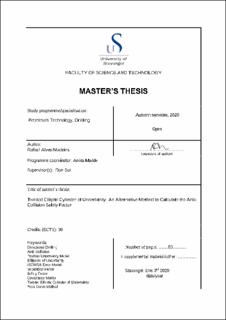| dc.contributor.advisor | Sui, Dan | |
| dc.contributor.author | Madeira, Rafael Alves | |
| dc.date.accessioned | 2021-06-16T07:34:05Z | |
| dc.date.available | 2021-06-16T07:34:05Z | |
| dc.date.issued | 2020-12-04 | |
| dc.identifier.uri | https://hdl.handle.net/11250/2759673 | |
| dc.description | Master's thesis in Petroleum Engineering | en_US |
| dc.description.abstract | A precise anti-collision analysis is becoming even more important in the past few years, with the increasing amount of wells being drilled in highly congested fields. The costs associated with the production fields have increased substantially in recent years, and with that, the necessity to enhance hydrocarbon recovery has also increased. One of the most adopted methods to enhance the recovery is to drill more wells in the same area.
Currently, the Ellipsoid Pedal-Curve method to calculate the Separation Factor is the most used and safe method. It is also the most conservative, and in many situations, it triggers an unnecessary early stop drilling due to limitations. This work aims to study a different method by using a different position uncertainty representation, a Twisted Elliptic Cylinder of Uncertainty, that can provide a more precise safety factor without triggering an early stop drilling situation and also keeping a safe operation.
The thesis utilizes the error model for Measuring While Drilling tools, provided by the Industry Steering Committee on Wellbore Survey Accuracy (ISCWSA). The model has 27 generic error sources used to calculate both Ellipsoid of Uncertainty and the Cylinder of Uncertainty. The individual direction uncertainties were calculated using the Pedal-Curve method and the Cylinder Surface method introduced in this work. The individual uncertainties can be defi ned as the size of the position uncertainty in the direction of the closest point to reference in the offset well path. The comparison has shown that the Cylinder Surface method presents a more optimistic (smaller) separation factor results
than the Pedal Radius, precisely indicating if the two wells have collided.
Three Separation Factor equations (ISCWSA, Equinor's, and a Simplified Version) were also compared throughout this work. The ISCWSA equation has shown more stability and robustness than the others, and it should be utilized as the main separation factor equation.
The results using the Twisted Elliptic Cylinder of Uncertainty as an alternative method to calculate the separation factor has shown a great potential to be used in the field, although it is still computationally demanding. The method still needs re finements, but it should be considered a viable method to determine the drilling operation's safety. | en_US |
| dc.language.iso | eng | en_US |
| dc.publisher | Stavanger, University of Stavanger | en_US |
| dc.relation.ispartofseries | Masteroppgave/UIS-TN-IEP/2020; | |
| dc.rights | Navngivelse 4.0 Internasjonal | * |
| dc.rights.uri | http://creativecommons.org/licenses/by/4.0/deed.no | * |
| dc.subject | petroleumsteknologi | en_US |
| dc.subject | petroleum engineering | en_US |
| dc.subject | directional drilling | en_US |
| dc.subject | anti-collision | en_US |
| dc.subject | position uncertainty model | en_US |
| dc.subject | ellipsoid of uncertainty | en_US |
| dc.subject | iscwsa error model | en_US |
| dc.subject | separation factor | en_US |
| dc.subject | safety factor | en_US |
| dc.subject | covariance matrix | en_US |
| dc.subject | twisted elliptic cylinder of uncertainty | en_US |
| dc.subject | pedal-curve method | en_US |
| dc.title | Twisted Elliptic Cylinder of Uncertainty: An Alternative Method to Calculate the Anti-Collision Safety Factor | en_US |
| dc.type | Master thesis | en_US |
| dc.subject.nsi | VDP::Teknologi: 500::Berg‑ og petroleumsfag: 510::Petroleumsteknologi: 512 | en_US |

